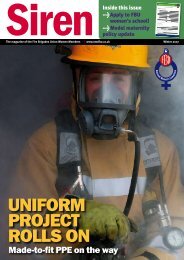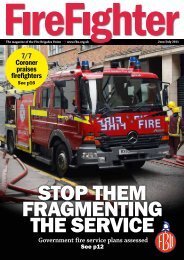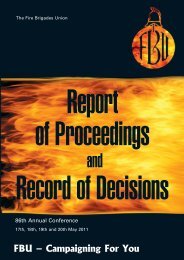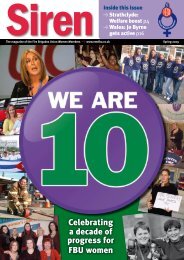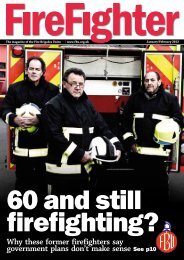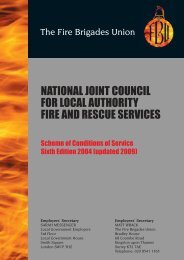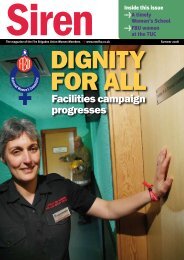Report - Fire Brigades Union
Report - Fire Brigades Union
Report - Fire Brigades Union
Create successful ePaper yourself
Turn your PDF publications into a flip-book with our unique Google optimized e-Paper software.
SECTION B — FIRE AND RESCUE SERVICE POLICY<br />
Option 2: Supported locally driven change<br />
To ensure faster and more consistent transfer of decisionmaking<br />
processes to a level closer to communities, and to<br />
provide a greater degree of citizen involvement, local<br />
measures could be reinforced through appropriate national<br />
or co-ordinated changes. These could be directed at the<br />
FRS governance structure, community engagement<br />
processes, and/or the way in which IRMP and resourcing<br />
decisions are made. They could be effected either through<br />
legislative change, concerted development action to be<br />
taken forward by the sector or other means, eg reflecting a<br />
revised National Framework approach.<br />
Option 3: New structural parameters<br />
These measures would require a significantly different<br />
framework for delivery of local services across the board<br />
empowered by government. They could potentially liberate<br />
services and might have three elements:<br />
●<br />
●<br />
●<br />
Integrated service commissioning – for a locality this<br />
could cover a range of local services, not just FRS,<br />
through pooled funding, with services commissioned<br />
shaped by local citizens and with a clear<br />
commissioning/provider split.<br />
Supply pluralism – both in terms of encouraging<br />
active citizen involvement in lower tiered interventions,<br />
and a plural supply of professionalised, reactive<br />
services, with varying geographical reaches and<br />
technical specialisms. For provision of FRS this might<br />
perhaps provide for supplier bodies under the<br />
ownership of firefighters themselves.<br />
Negotiated mechanisms for strategic coordination,<br />
arising from the needs of both local commissioning and<br />
national government, so that local control of services<br />
can be reconciled with other policy objectives.<br />
3. DELIVERY MEASURES FOR THE FRS<br />
In taking forward this work, contributors have identified a<br />
wide range of specific potential measures to enable FRAs<br />
to deliver this agenda. These are the types of measures<br />
FRAs may wish to consider locally in developing their own<br />
models and, within the context of Options 2 and 3, some<br />
might be considered for universal change to support the<br />
agenda more coherently at a national level. These have<br />
focussed particularly on the areas of:<br />
● The way in which decisions on spending/resources are<br />
made;<br />
● The planning of services;<br />
● The governance structure; and<br />
● The delivery of services.<br />
Examples included:<br />
Spending/Resources<br />
This area can be split between funding and expenditure.<br />
●<br />
Funding could arrive at the body from a number of<br />
sources, eg precept, grants or pooled funding. The<br />
most important issue here is transparency so that the<br />
community is aware of where it comes from and how<br />
it can be used. This will enable local accountability and<br />
so public engagement in determining the level of<br />
resources needed.<br />
In terms of how funding is spent the same accountability<br />
and transparency agenda must equally apply, so:<br />
●<br />
●<br />
●<br />
Some funding could be pooled into area-based funding<br />
streams with other public services. The level of pooled<br />
funding could be set by local engagement;<br />
The service must consult with communities, potentially<br />
collectively with other public services, to consider the<br />
current nature of provision and determine whether it is<br />
still possible/desirable to offer the services they<br />
currently provide;<br />
Some portions of funding could be delegated at a<br />
locality or even station level with communities directly<br />
involved in decisions on its use.<br />
Planning<br />
● IRMP is just one method of planning but it could be<br />
developed to become a core tool used in collective<br />
local public service planning, while also addressing<br />
national risk. FRAs could use it to engage with local<br />
citizens and develop a ‘place map’ of community risks,<br />
aims and priorities. The IRMP could potentially<br />
incorporate/recognise specific rights for citizens and<br />
include service level agreements with communities;<br />
●<br />
Key to engaging local people is to encourage them to<br />
think beyond the provision of emergency response and<br />
how to reconcile what they want with what they need.<br />
Engagement needs to be an iterative process in itself<br />
in facilitating public awareness of fire service functions<br />
and these need to go beyond passive consultation<br />
exercises. But it is recognised that there are some<br />
areas where public decision making would be<br />
inappropriate, such as risk assessments.<br />
Governance<br />
● An option for combined/metropolitan FRAs might be to<br />
develop nationally/adopt locally an alternative structure<br />
with a smaller number of authority members overall<br />
together with the inclusion of independents to give a<br />
clearer voice to local priorities in line with other public<br />
service models;<br />
●<br />
●<br />
●<br />
County FRAs could look at other mechanisms to<br />
increase local community and independent<br />
involvement in scrutiny and governance structures;<br />
An alternative for all types for FRAs would be to create<br />
a single form of governance within which they can<br />
work together in the national interest, whilst also<br />
meeting the localism agenda. The different governance<br />
arrangements currently in existence do not enable the<br />
widest opportunities for collaboration, as has been<br />
seen through the operation of Regional Management<br />
Boards;<br />
Such an alternative approach could incorporate better<br />
representation for all tiers of local government and the<br />
private, third sector and even service management or<br />
FBU Annual <strong>Report</strong> 2011 51





